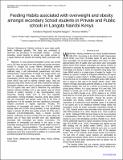| dc.contributor.author | Rapando, Constance | |
| dc.contributor.author | Nyagero, Josephat | |
| dc.contributor.author | Wakhu, Florence | |
| dc.date.accessioned | 2021-08-20T13:41:04Z | |
| dc.date.available | 2021-08-20T13:41:04Z | |
| dc.date.issued | 2017-05 | |
| dc.identifier.citation | Rapando, Constance et al. “Feeding Habits associated with overweight and obesity amongst secondary School students in Private and Public schools in Langata Nairobi Kenya.” (2017). | en_US |
| dc.identifier.issn | 2250-3153 | |
| dc.identifier.uri | http://repository.amref.org/handle/123456789/110 | |
| dc.description | International Journal of Scientific and Research Publications, Volume 7, Issue 5, May 2017 | en_US |
| dc.description.abstract | Background; Obesity continues to pose major public
health challenges globally. This study was conducted to
determine the prevalence of overweight /obesity amongst
secondary school students in private and public schools in
Langata Nairobi and identify the feeding habits associated with
it.
Methods: A cross-sectional descriptive survey was carried
out on 292 boys and girls from both public and private secondary
schools in Langata sub county Nairobi. Multistage random
sampling was used to select the study participants. Data was
collected using a self administered questionnaire and direct
anthropometric measurements of height and weight which was
used to calculate Body mass index. The World Health
Organization (WHO) Age and gender specific BMI- for –age Zscores (BAZ) was used to classify nutrition status. Data was
analyzed using SPSS version 20 and WHO AnthroPlus software.
Descriptive statistics were used to analyze quantitative variables.
The Chi square tests were used to determine any association
between selected variables such as age, gender, type of school
(private or public), boarding or day, parent/guardian car(s)
ownership, feeding habits such as fruit and vegetable
consumption, missing breakfast, snacking, caring about portion
size and overweight and obesity using 0.05 as the level of
significance. For the variables that were significant at bivariate,
analysis proceeded to logistic regression. Results: The
prevalence of overweight and obesity was 17.8 %( 16.96%
among males and 20.59% among females). It was significantly
higher in private (23.45%) than public schools (12.24%) with a
computed p=0.047Additionally, being a boarder p=0.004,
parents’ ownership of car(s) p=0.004 and not caring about the
portion size of food eaten p=0.008 were also significantly
associated with overweight and obesity. Conclusion: The
prevalence of overweight and obesity in this study is high
especially among girls and should be of public health concern to
policy planners .Recommendation: The government should
consider increasing time for physical education in schools and
introducing some levy on junk food in addition to a school health
and fitness programme involving parents. | en_US |
| dc.language.iso | en | en_US |
| dc.publisher | IJSRP Publications | en_US |
| dc.subject | Adolescents | en_US |
| dc.subject | Body Mass Index | en_US |
| dc.subject | Kenya | en_US |
| dc.subject | Obesity | en_US |
| dc.subject | Overweight | en_US |
| dc.title | Feeding Habits Associated with Overweight and Obesity Amongst Secondary School Students in Private and Public Schools in Langata Nairobi Kenya | en_US |
| dc.type | Article, Journal | en_US |

